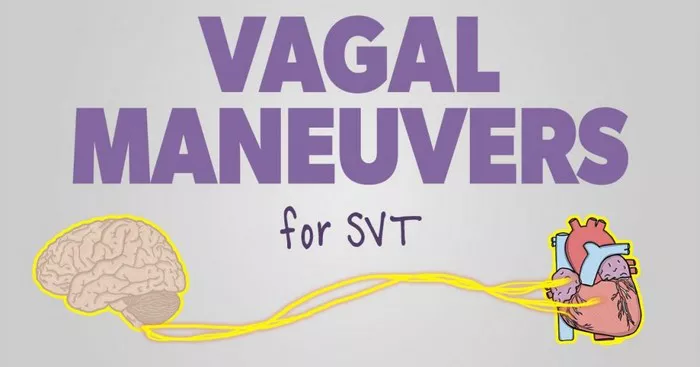Vagal maneuvers are a set of techniques used to treat certain types of abnormal heart rhythms, particularly supraventricular tachycardia (SVT). These maneuvers work by stimulating the vagus nerve, which plays a crucial role in regulating heart rate and rhythm. While vagal maneuvers are generally safe and effective, they should only be performed under the guidance of a healthcare professional. This article provides an in-depth exploration of vagal maneuvers, their mechanisms of action, when they are used, and important considerations for their implementation.
What is the Vagus Nerve?
Before delving into vagal maneuvers, it’s essential to understand the vagus nerve and its role in the body. The vagus nerve, also known as the tenth cranial nerve or CN X, is a long and complex nerve that extends from the brainstem to various organs in the body, including the heart, lungs, and digestive tract. It is a key component of the autonomic nervous system, which controls involuntary bodily functions such as heart rate, digestion, and respiratory rate.
The vagus nerve has both sensory and motor functions. Sensory fibers of the vagus nerve carry information from the body’s organs to the brain, providing feedback about physiological processes such as heart rate and blood pressure. On the other hand, motor fibers of the vagus nerve send signals from the brain to organs, controlling activities such as heart rate modulation and gastrointestinal motility.
What Are Vagal Maneuvers?
Vagal maneuvers refer to specific techniques used to stimulate the vagus nerve, leading to changes in heart rate and rhythm. These maneuvers are primarily employed in the management of supraventricular tachycardia (SVT), a condition characterized by rapid heartbeats originating above the ventricles. SVT can cause symptoms such as palpitations, dizziness, chest discomfort, and shortness of breath.
The goal of vagal maneuvers is to interrupt the abnormal electrical pathways responsible for SVT and restore a normal heart rhythm. It’s important to note that vagal maneuvers are not suitable for all types of arrhythmias and may not be effective in certain situations. Therefore, their use should be guided by healthcare professionals with expertise in cardiac care.
Common Vagal Maneuvers
Several vagal maneuvers have been identified as effective in terminating SVT episodes. These maneuvers are typically simple and can be performed without specialized equipment. However, they should be done cautiously and with awareness of potential risks. Some common vagal maneuvers include:
1. Valsalva Maneuver: This maneuver involves bearing down as if having a bowel movement while holding the breath or blowing against a closed glottis (the space between the vocal cords). The increased intrathoracic pressure during the Valsalva maneuver can stimulate the vagus nerve and slow down the heart rate.
2. Carotid Sinus Massage: This technique involves gently massaging the carotid sinus, a sensitive area located in the neck where the carotid artery bifurcates. Carotid sinus massage stimulates the baroreceptors in the carotid sinus, leading to vagal nerve activation and heart rate reduction.
3. Cold Water Facial Immersion: Plunging the face into ice-cold water or applying a cold, wet towel to the face can trigger the mammalian diving reflex, which includes vagal activation and bradycardia (slowing of the heart rate). This maneuver is less commonly used but may be effective in some individuals.
4. Valsalva Variant Maneuvers: Variations of the Valsalva maneuver, such as the modified Valsalva or “straining against a closed glottis” technique, can also be employed to stimulate the vagus nerve and terminate SVT episodes.
Indications and Considerations
Vagal maneuvers are typically considered first-line interventions for terminating stable SVT episodes in conscious patients. They are particularly useful when the patient does not have access to medical facilities or when immediate pharmacological interventions are not feasible. However, several considerations must be taken into account:
1. Patient Suitability: Vagal maneuvers may not be suitable for all patients, especially those with certain cardiac conditions or contraindications to vagal stimulation. Healthcare providers should assess each case individually before recommending vagal maneuvers.
2. Effectiveness: While vagal maneuvers can successfully terminate many SVT episodes, they are not always effective. If a vagal maneuver fails to restore normal rhythm, other interventions such as medications or electrical cardioversion may be necessary.
3. Risk of Complications: Although vagal maneuvers are generally safe, they can sometimes lead to adverse effects such as syncope (fainting), bradycardia (excessively slow heart rate), or hypotension (low blood pressure). These risks underscore the importance of proper training and supervision when performing vagal maneuvers.
4. Training and Education: Patients with a history of SVT or at risk for SVT recurrence should receive education about vagal maneuvers and when to use them. Healthcare providers play a crucial role in teaching patients and caregivers the correct techniques and potential risks associated with vagal maneuvers.
Conclusion
Vagal maneuvers are valuable tools in the management of supraventricular tachycardia, offering a non-invasive and accessible means of restoring normal heart rhythm. Understanding the mechanisms of vagal stimulation, common maneuvers, indications, and considerations is essential for healthcare professionals involved in cardiac care. By integrating vagal maneuvers into comprehensive treatment strategies and ensuring patient education, healthcare providers can enhance the management of SVT and improve patient outcomes.


